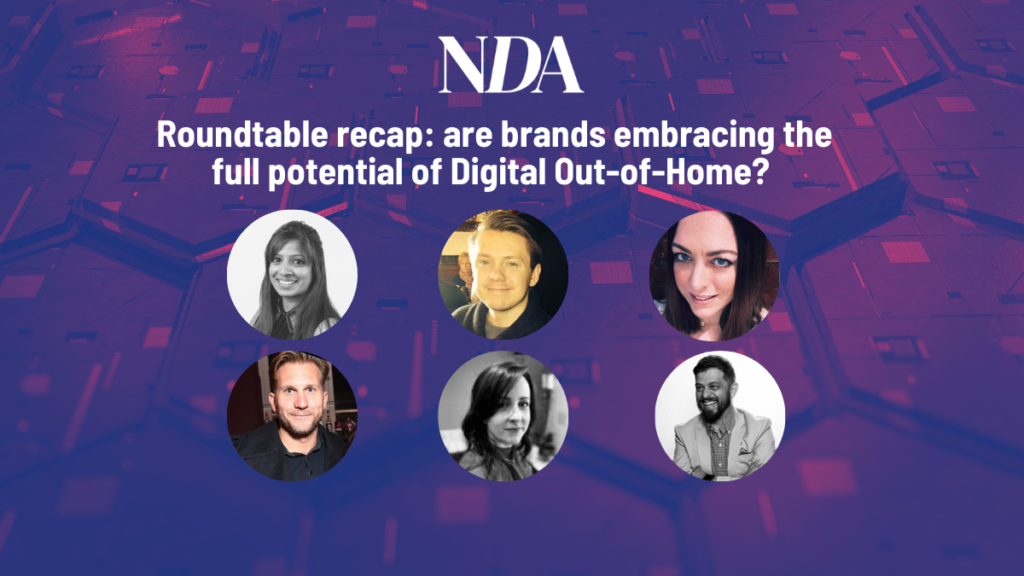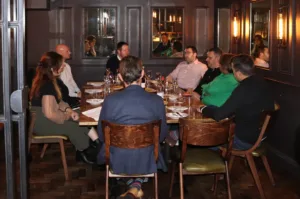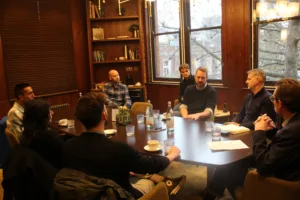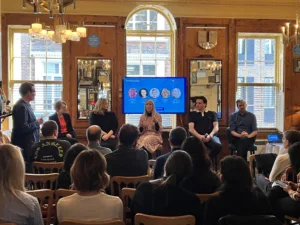Are brand advertisers and their agencies fully aware of the capabilities of contemporary programmatic Digital Out of Home (DOOH) advertising? Who is most responsible for getting the message across? With contextual ad solutions increasingly in demand, what sticking points still exist for advertisers in leveraging the power of DOOH across the full marketing funnel?
New Digital Age (NDA) recently assembled a panel of industry experts to discuss these questions and more. NDA’s editor-in-chief Justin Pearse chaired the roundtable discussion and was joined by: Simon Jenkins, Joint Chief Strategy Officer at VCCP; Jackie Lyons, Head of Planning (Media Experience) at Havas Media Group; Cheryl Crilley, Business Director at Kinetic Worldwide; Nadia Stowell, OOH Business Director at Spark Foundry; Lee Cutter, Vice President, Sales (UK & Emerging Markets) with Hivestack; and Jem Djemal, Global New Business Lead at VIOOH.
Simon Jenkins of VCCP opened the discussion by questioning whether the levels of industry hype surrounding DOOH was being matched by campaign activity on the ground. He said: “DOOH is one of those media where there’s a lot of conceptual excitement. Big sexy media + data equals = more contextual relevance and impact, right? While some brands are using things like the weather conditions, time of day and traffic levels as triggers for targeted DOOH ads, the reality is that, at the moment, only a fraction of DOOH inventory is actually being traded in that hyper-targeted, programmatic way. Despite the excitement around DOOH, I wonder if enough marketers really understand it.”
Jackie Lyons, Havas Media Group, argued that agencies have a major role to play in educating their clients on the potential benefits of programmatic DOOH. She said: “If clients were already big outdoor spenders, most agencies will have introduced at least the layman’s version of programmatic DOOH to them by now. Right now, the majority of DOOH inventory doesn’t have any contextual messaging or proper targeting, so many clients are still on a journey with this. For me, it’s up to agencies to better define where programmatic outdoor sits within a client’s media plan. Today, outdoor advertising has capabilities that simply weren’t there when I started in the business. It’s remarkable how few brands are currently taking advantage of that.”
However, Hivestack’s Lee Cutter believes that despite the relatively low spending on DOOH, the format is gaining momentum and “has started to go more mainstream”.
Cutter said: “Our platform is doubling in size year-on-year, with more demand and new partners coming in all the time. Our supply in the UK is where it needs to be. I think the pandemic and the regional lockdowns helped to demonstrate the agility and speed-to-market of DOOH. Outdoor campaigns are now capable of being turned on and off with a couple of clicks. One issue is that some media owners need to lean in more to programmatic DOOH as the demand increases. Not all screens have the same capabilities, so there needs to be investment and more inventory needs to be made available programmatically.”
Screen measurements
Nadia Stowell of Spark Foundry warned brand marketers not to flock to programmatic DOOH simply because it’s new and exciting. Rather, they should make sure they have the right data and right strategy to make DOOH work in the context of their own objectives and KPIs.
She said: “If we want more brands to integrate DOOH across the full marketing funnel, we need more case studies. There’s still a huge job to be done in showcasing the outcomes from DOOH campaigns. Traditional outdoor advertising has long been considered one of the hardest media for marketers to measure, so programmatic DOOH affords us an opportunity to address that with brand uplift studies, footfall studies and other real-world success stories. We try to do as many studies as possible and lean on DSPs like Hivestack and The Trade Desk to help us with those.”
While clients typically value the real-time flexibility of buying programmatic DOOH, Cheryl Crilley of Kinetic believes that the real USP of the format is the ability to make adjustments, upweighting and downweighting different locations and environments , while mid-campaign.
Crilley said: “We’re definitely seeing an increase in clients and agencies using DOOH in the right way and all the available research suggests that consumers welcome it too, with brand metrics, sales, memorability all moving in the right direction. I agree that media owners have a big part to play in the growth of DOOH by digitising more of their inventory, upgrading their software and so on, to really drive its capabilities.
“That said, if we focus entirely on the digital side of OOH, we’re in danger of taking away from the unique beauty of OOH as a mass awareness channel. It’s a one-to-many broadcast medium that’s sexy and sleek. I would be interested to see more studies on how a blend of pDOOH and traditional OOH delivers impact for brands. Usually research focuses on one or the other but not both. Film releases, for example, frequently make use of both traditional OOH and DOOH at different stages of the campaign.”
Jem Djemal of VIOOH also emphasised the key role of media owners in ensuring that programmatic DOOH reaches its full potential. He said: “Media owners are starting to see incremental value from programmatic DOOH campaigns and, often, from new sources, so that’s giving them encouragement. As a result, they’re starting to look at things that they probably wouldn’t have considered before, like dynamic creative optimisation, working with third parties, allowing others to mark their homework with ‘proof of play’ arrangements. These were taboo subjects just a couple of years ago. Media owners are waking up to the fact that if they want to be serious players in programmatic DOOH, they’ll need to adapt.”
Read the second part of this NDA Roundtable discussion here.









